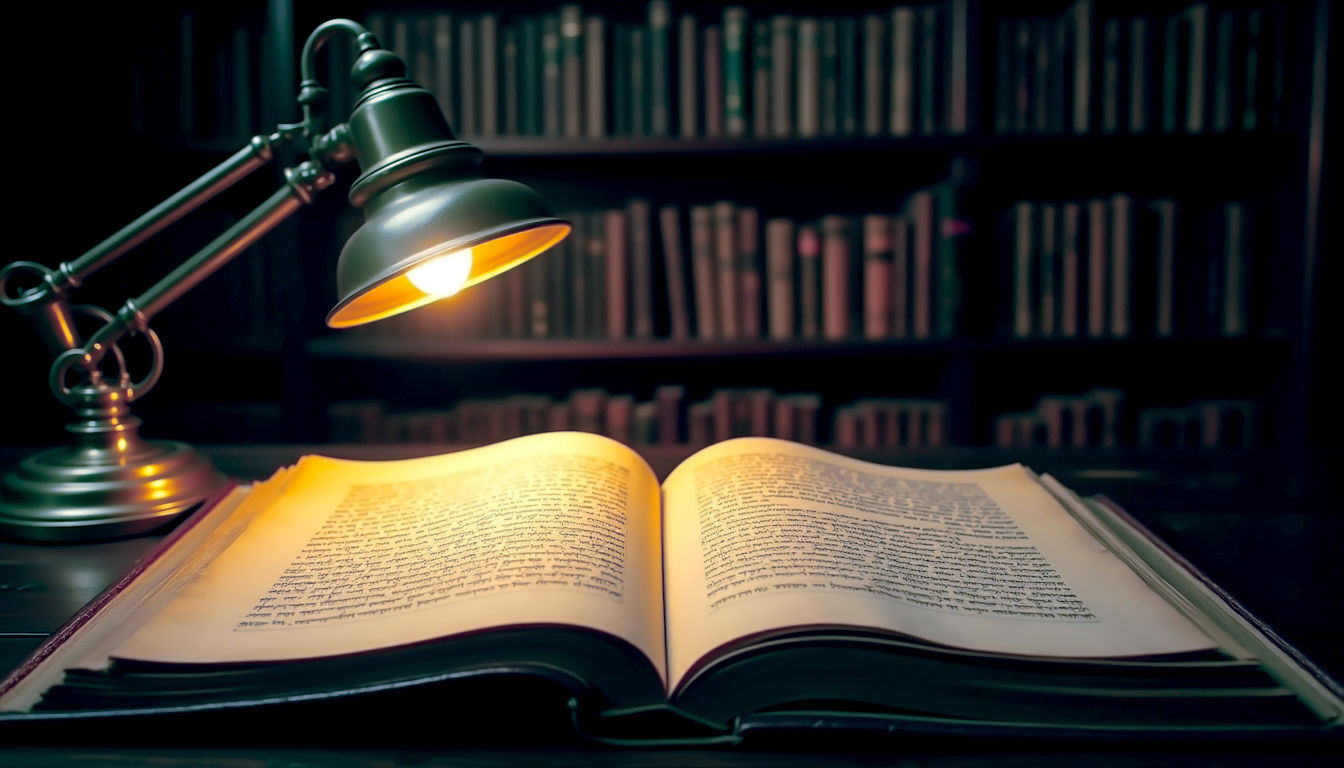The Soul’s Blueprint: A Complete Guide to Ācārya Nemicandra’s Dravyasamgraha
A deep dive into Ācārya Nemicandra’s Dravyasamgraha, explaining Jain concepts of soul (Jiva), matter, and liberation for a modern reader.

This post may contain affiliate links. If you make a purchase through these links, we may earn a commission at no additional cost to you.
Ever wondered what the universe is really made of? Not just the planets and stars and the cup of tea in your hand, but everything. The space they exist in. The time that makes them change. Even the very idea of movement itself. It’s a question that has kept philosophers and scientists busy for thousands of years.
Way back in the 10th century, an Indian sage and scholar named Ācārya Nemicandra decided to create a definitive guide to answer this very question. He wasn’t a physicist in a lab; he was a Jain monk, part of an ancient tradition that has been exploring the nature of reality and consciousness for millennia. His masterpiece, the Dravyasamgraha, or “Compendium of Substances,” is one of the most important texts in Jain philosophy.
But this isn’t some dusty, forgotten text. Think of it less as a history book and more as a detailed blueprint for reality—a user’s manual for the soul. It explains what you are, what the world around you is, and how you fit into the grand cosmic scheme. For anyone in modern Britain feeling a bit lost in the noise of daily life, the Dravyasamgraha offers a crystal-clear framework for understanding existence itself. It’s a short, powerful guide that gets straight to the point.
So, let’s pull back the curtain on this thousand-year-old wisdom. We’ll break down its core ideas, explore the profound map it offers for spiritual progress, and discover why its ancient insights are more relevant today than ever.
Who Was Ācārya Nemicandra? The Master Synthesiser
Before we dive into the book, it’s worth knowing the man behind it. Ācārya Nemicandra Siddhānta Cakravartī lived around the 10th century CE in Southern India, primarily in what is now the state of Karnataka. He wasn’t just any monk; he was a giant of intellect, a spiritual guide, and a brilliant teacher.
His title, “Siddhānta Cakravartī,” translates to “Emperor of the Scriptures.” It was a mark of immense respect, given to him for his unparalleled mastery over the vast body of Jain philosophical texts (the Siddhāntas). He had a special talent for taking incredibly complex, sprawling ideas and distilling them into their purest, most understandable form.
Imagine trying to explain the entire history of the British monarchy, the rules of cricket, and the London Underground map to someone in just a few pages. That’s the kind of challenge Nemicandra took on with Jain philosophy. He was a master synthesiser.
The Dravyasamgraha is his most famous work precisely because it’s so concise. In just 58 verses written in a language called Prakrit, he lays out the entire Jain worldview. It was written for both monks and laypeople, designed to be a foundational text that anyone could memorise and reflect upon. It’s a testament to his genius that this short work became one of the most studied and revered texts in the Digambara school of Jainism.
What Exactly is the Dravyasamgraha? A Pocket Guide to Reality
The name itself gives us the biggest clue. Dravya means “substance” or “entity,” and Samgraha means “compendium” or “collection.” So, it’s literally a “Compendium of Substances.”
According to Jainism, the entire universe, everything that has ever existed or will ever exist, is made up of six eternal, uncreated, and indestructible substances. These are the fundamental building blocks of reality. The Dravyasamgraha is Nemicandra’s clear, organised guide to understanding these six substances and how they interact.
It’s structured beautifully:
- The Six Substances (Dravyas): The first part of the text describes what the universe is made of.
- The Seven Realities (Tattvas): The second part explains how these substances interact, particularly how the soul becomes entangled with the material world.
- The Path to Liberation (Moksha Marga): The final part provides the solution—the practical steps one must take to free the soul from this entanglement and achieve its true state of bliss.
It’s a complete system: it tells you what’s real, what the problem is, and how to solve it. Now, let’s look at the core of its teaching: the six substances that make up everything.
The Building Blocks of Everything: Unpacking the Six Dravyas
This is the heart of the Dravyasamgraha. Nemicandra explains that reality isn’t just one thing (like energy or matter) but is composed of six distinct, fundamental substances. They are divided into two main categories: Jīva (the living) and Ajīva (the non-living).
Let’s break them down one by one.
1. Jīva: The Spark of Life (You!)
The first and most important substance is Jīva, which means the soul or living substance. This is the principle of consciousness, the life force that exists in every living being, from the tiniest microbe to a human.
- Simplified Explanation: Think of the Jīva as the driver of a car. The car itself is the body, but the Jīva is the conscious being inside, the one who experiences, feels, knows, and decides.
- Detailed Explanation: The defining characteristic of Jīva is cetanā (consciousness). This consciousness has several key functions, including jñāna (knowledge) and darśana (perception). According to Jainism, every soul, in its pure state, possesses infinite knowledge, infinite perception, infinite bliss, and infinite power. However, due to its entanglement with matter (which we’ll get to next), these qualities are obscured. The whole point of the Jain spiritual path is to cleanse the soul and let these innate qualities shine through. There are an infinite number of Jīvas in the universe, each one a unique, individual entity.
2. Pudgala: The Stuff of the Universe
The most familiar of the non-living substances is Pudgala, which is best translated as Matter.
- Simplified Explanation: If the Jīva is the driver, Pudgala is everything physical. It’s the car, the fuel, the road, the air, the light—absolutely everything you can touch, taste, see, smell, or hear. It’s the building block of the physical world.
- Detailed Explanation: Pudgala is the only substance that has physical form (rūpa). It is made of infinitesimally small particles called paramānu (the ultimate atom). These atoms can combine to form larger aggregates called skandha. Sound, darkness, light, and energy are all considered forms of Pudgala. Crucially, it’s Pudgala that forms the bodies of living beings and, most importantly, the subtle karmic particles that attach to the soul (Jīva), obscuring its true nature. This interaction between Jīva and Pudgala is the source of the cycle of birth and death (samsāra).
The next four substances are a bit more abstract. They don’t have physical form, but they are essential for the functioning of the universe. They are facilitators, creating the conditions for everything else to exist and interact.
3. Dharma: The Invisible Road for Motion
This is where things get really interesting. Dharma-dravya is not “religion” or “duty” as the word often means in other Indian traditions. In Jain metaphysics, it is the Medium of Motion.
- Simplified Explanation: Imagine a fish in water. The fish wants to swim, and it uses its own power to do so. But it can only swim because the water is there to support its movement. Dharma is like the water for all Jīvas and Pudgala. It doesn’t make you move, but it provides the invisible medium that allows motion to happen.
- Detailed Explanation: Dharma is a single, continuous substance that permeates the entire cosmos (the loka). It is passive. It has no consciousness and no form. Without it, no soul or piece of matter could move from one place to another, even if it had the energy to do so. It’s like the railway tracks for a train; the train moves under its own power, but it can’t go anywhere without the tracks.
4. Adharma: The Universal Brake Pedal
As you might guess, Adharma-dravya is the opposite of Dharma. It is the Medium of Rest.
- Simplified Explanation: Just as Dharma allows things to move, Adharma allows them to stop and stay still. If you’re walking and decide to rest, you can only do so because the ground is there to support you. Adharma is like the universal ground. It doesn’t force you to stop, but it makes resting possible.
- Detailed Explanation: Like Dharma, Adharma is also a single, formless substance that fills the cosmos. It is the necessary condition for any Jīva or Pudgala to cease moving. Without Adharma, everything would be in a state of perpetual motion. Think of a station platform for our train analogy. The platform doesn’t pull the train in, but its presence is what makes it possible for the train to stop at the station. Together, Dharma and Adharma provide the fundamental principles of dynamics for the Jain universe.
5. Ākāśa: The Ultimate Container
Ākāśa is Space. It’s the substance that provides a place for everything else to exist.
- Simplified Explanation: Ākāśa is like the air in a room. The furniture, people, and everything else in the room exist within the space provided by the air. Ākāśa is the ultimate container for the entire universe.
- Detailed Explanation: Jain philosophy divides space into two parts. Lokākāśa is the “occupied space,” where the other five substances (Jīva, Pudgala, Dharma, Adharma, and Kāla) exist. This is what we would call the cosmos or the universe. Beyond this is Alokākāśa, the infinite, empty, “unoccupied space” where nothing else exists. Ākāśa’s function is to give avagāha (accommodation) to all the other dravyas. It’s the master container.
6. Kāla: The Engine of Change
The final substance is Kāla, or Time.
- Simplified Explanation: Kāla is what allows for change. It’s the ticking clock of the universe that turns a seed into a tree, a young person into an old one, and a new object into a worn-out one. It’s the dimension in which everything happens.
- Detailed Explanation: Kāla is what facilitates vartanā (transformation or modification). It helps other substances pass through their different states. A lump of clay becomes a pot, which then breaks and returns to dust. Kāla is the substance that underpins this continuity and change. Nemicandra explains that time is understood through the changes we see in other things. Unlike the other formless substances, Kāla is not a single continuous entity filling the cosmos; rather, it’s conceived as countless minute, individual particles existing only in the Lokākāśa.
These six substances, working in harmony, form the complete, self-sustaining system of the Jain universe. It’s a reality that wasn’t created by a god and will never be destroyed. It simply is.
The Map to Freedom: The Path to Moksha
Understanding the six substances is the first step. It’s the “You Are Here” on the cosmic map. The second part of the Dravyasamgraha explains why this knowledge is crucial: it’s the key to achieving Moksha, or liberation.
The problem, as Nemicandra lays it out, is that the soul (Jīva) has been entangled with matter (Pudgala) since time immemorial. This entanglement is caused by karma, which in Jainism is understood as a form of subtle matter that sticks to the soul due to our thoughts, words, and actions, especially those driven by passion and ignorance. This karmic dust clouds the soul’s natural qualities of infinite knowledge and bliss, trapping it in the cycle of rebirth.
The solution is to stop the influx of new karma and gently shed the old karma that has already attached itself to the soul. When all karma is removed, the soul achieves its pure, liberated state. Nemicandra explains that this is accomplished through the Ratnatraya, or the Three Jewels.
The Three Jewels: A Treasure Worth Seeking
The path to liberation is a unified practice of three things, which must be cultivated together.
#### Right Faith (Samyak Darshan)
This is the starting point. It means having a firm and unwavering belief in the true nature of reality as explained in the Jain teachings—belief in the six dravyas, the soul, and the path to liberation. It’s not blind faith; it’s a deep conviction that comes from rational understanding. It’s about seeing the world for what it truly is.
#### Right Knowledge (Samyak Jnana)
Once you have the right perspective, you need to fill it with the right information. This means having a detailed and correct understanding of the six substances and the workings of karma. It’s about knowing, without doubt or error, the nature of the self and the non-self. Right Faith gives you the right lens; Right Knowledge allows you to see clearly through it.
#### Right Conduct (Samyak Charitra)
This is where faith and knowledge are put into practice. It’s about living your life in a way that aligns with your understanding. For Jain monks and nuns, this involves observing five great vows (Mahavratas):
- Ahimsa (Non-violence): Not harming any living being through thought, word, or deed.
- Satya (Truthfulness): Speaking only the truth.
- Asteya (Non-stealing): Not taking anything that is not freely given.
- Brahmacharya (Celibacy/Chastity): Abstaining from sensual indulgence.
- Aparigraha (Non-possession/Non-attachment): Limiting possessions and detaching from worldly things.
For laypeople, these vows are followed in a less strict form known as the Anuvratas (minor vows), adapted to the realities of daily life. The goal of Right Conduct is to purify one’s behaviour to prevent the influx of new karma.
Nemicandra is clear: these three jewels are not separate paths. They are three facets of a single, integrated path. You can’t have one without the others, just as you can’t have a cure without the right diagnosis and the right medicine.
Climbing the Ladder: The Fourteen Stages of Spiritual Progress (Gunasthanas)
The Dravyasamgraha also touches upon a more advanced concept: the Gunasthanas, or the fourteen stages of spiritual development.
- Simplified Explanation: Think of the spiritual journey as climbing a 14-rung ladder. The bottom rung represents a state of complete ignorance and delusion, where the soul doesn’t even know it’s a soul. The top rung is total liberation, where all karma has been eliminated.
- Detailed Explanation: Each Gunasthana represents a specific state of the soul, defined by the degree to which passions like anger, ego, deceit, and greed are controlled, and the extent to which karmic bondage has been loosened. The journey begins when a soul, for the first time, achieves a moment of true insight (Samyak Darshan), moving from the first stage to the fourth. The path then involves progressively purifying conduct, moving through stages of deeper meditation and detachment, until finally, in the 14th stage, the soul sheds its last karmic particles just before leaving its physical body for good, achieving Moksha.
This framework provides a detailed psychological and spiritual map, showing the precise path a soul takes from bondage to freedom.
Why the Dravyasamgraha Still Matters in Modern Britain
It’s easy to dismiss a thousand-year-old text from another culture as irrelevant. But the core questions Nemicandra addresses are universal and timeless.
- A Framework for Ethical Living: At a time when we are more aware than ever of our impact on the planet and each other, the Jain principle of Ahimsa (non-violence) is profoundly relevant. The Dravyasamgraha provides the metaphysical foundation for this ethic: if every living thing possesses a conscious soul (Jīva), then all life is deserving of respect and protection.
- Understanding Consciousness: The text’s focus on the soul (Jīva) as a substance of pure consciousness offers a powerful counterpoint to a purely materialistic worldview. In a world grappling with questions about AI, consciousness, and what it means to be human, this ancient perspective provides a rich source of insight.
- A Path to Inner Peace: The principle of Aparigraha (non-attachment) is a powerful antidote to modern consumerism. Nemicandra’s work reminds us that true happiness comes not from acquiring more material things (Pudgala) but from purifying our inner self (Jīva) and detaching from the external. It’s a clear and practical philosophy for finding peace in a chaotic world.
- Clarity and Simplicity: Perhaps its greatest strength is its clarity. In just 58 verses, it offers a complete, logical, and coherent system for understanding reality. It doesn’t ask for blind faith; it presents a model of the universe and asks you to understand it. For anyone seeking spiritual answers without dogma, it’s an incredibly refreshing and empowering guide.
Conclusion: A Timeless Guide to What Matters
The Dravyasamgraha is far more than just a compendium of substances. It’s a handbook for life. Ācārya Nemicandra didn’t just create a list; he drew a map. He mapped the terrain of reality, identified the place where we are stuck, and charted a clear, direct route to freedom.
He tells us that we are not just our bodies or our thoughts. We are Jīva—a pure, conscious, blissful soul. He explains that the universe is a rational, ordered system, not a random chaos. And he shows us that through the Three Jewels of Right Faith, Right Knowledge, and Right Conduct, we have the power to reclaim our true nature.
In a world that often feels overwhelmingly complex, this ancient text offers a message of profound simplicity and hope. It reminds us what is essential, what is eternal, and what is truly worth striving for. It is, in short, a blueprint for the soul, as clear and relevant in 21st-century Britain as it was in 10th-century India.
Further Reading
For those interested in exploring this topic further, these resources provide authoritative and in-depth information:
- Jain eLibrary: An extensive digital library containing scriptures, dictionaries, and scholarly articles on Jainism. A search for “Dravyasamgraha” will yield numerous translations and commentaries.
- The Institute of Jainology (UK): Based in London, this organisation promotes Jain philosophy and values in the UK and provides excellent resources for learning.
- Jain World: A comprehensive website covering all aspects of Jainism, including detailed explanations of its core philosophical concepts.






